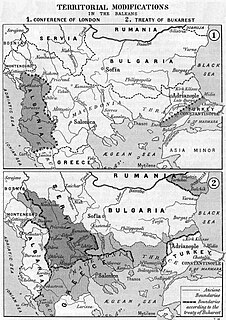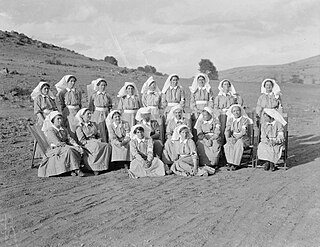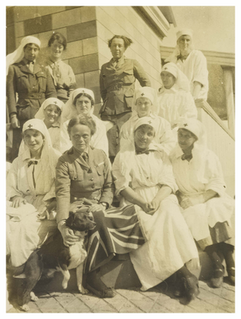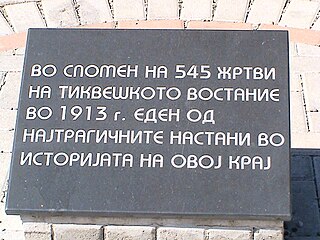 W
WVardar Macedonia was the name given to the territory of the Kingdom of Serbia (1912–1918) and Kingdom of Yugoslavia (1918–1941) roughly corresponding to today's North Macedonia. It covers the northwestern part of geographical Macedonia, whose modern borders came to be defined by the mid-19th century.
 W
WThe Battle of Kosturino was a World War I battle, fought between 6 and 12 December 1915. The battle was fought in the initial stage of the Macedonian campaign, in the Balkans Theatre. On December 6, a Bulgarian troops attacked the French and British-held trenches in Kosturino, at the time part of the Kingdom of Serbia. The offensive was at first held in check, however on December 8, Bulgaria managed to infiltrate the Memesli ravine. Bulgaria then seized Crete Simonet, thus threatening to outflank the Allies. The Entente defeat at Kosturino led to the complete withdrawal of Allied forces from Serbia, thus enabling the Central Powers to build the Berlin to Constantinople rail line. The Allies in the meantime concentrated on solidifying their defenses in Greece.
 W
WThe Battle of Prilep in the First Balkan War took place on November 3, 1912. The Serbian army encountered Ottoman troops near the town of Prilep, in today's North Macedonia. The clash lasted for three days, and the Ottoman army was overwhelmed and forced to retreat.
 W
WThe Battle of the Crna bend was a two-month-long battle between the Bulgarian and Entente armies. The battle took place in the Macedonian front during the First World War Allied Monastir Offensive in October and November 1916. After extremely heavy fighting and severe casualties on both sides, the Bulgarians retreated from Bitola on the 19 November and took positions at 5 km to the north defeating all later attacks from there. However, the Entente entry in Bitola had no strategic value.
 W
WThe Battle of Bregalnica was fought between the Kingdom of Bulgaria army and the Kingdom of Serbia during the Second Balkan War. It was the largest battle of the war.
 W
WThe Treaty of Bucharest was concluded on 10 August 1913, by the delegates of Bulgaria, Romania, Serbia, Montenegro and Greece. The Treaty was concluded in the aftermath of the Second Balkan War and amended the previous Treaty of London, which ended the First Balkan War. About one month later, the Bulgarians signed a separate border treaty with the Ottomans, who had regained some territory west of the Enos-Midia Line during the second war.
 W
WThe Battle of Dobro Pole, also known as the Breakthrough at Dobro Pole, was a World War I battle fought between 15 and 18 September 1918. The battle was fought in the initial stage of the Vardar Offensive, in the Balkans Theatre. On 15 September, a combined force of Serbian, French and Greek troops attacked the Bulgarian-held trenches in Dobro Pole, at the time part of the Kingdom of Serbia. The offensive and the preceding artillery preparation had devastating effects on Bulgarian morale, eventually leading to mass desertions.
 W
WThe Third Battle of Doiran was fought from 18–19 September 1918, with the Greeks and the British assaulting the positions of the Bulgarian First Army near Dojran Lake. The battle was part of World War I and took place in the Balkan Theatre. The battle ended with the Bulgarians repulsing all attacks.
 W
WThe Battle of Doiran was a 1917 battle between the United Kingdom and Bulgaria during World War I.
 W
WThe Battle of Krivolak was a World War I battle, fought between 21 October and 22 November 1915. The battle was fought in the initial stage of the Macedonian campaign, in the Balkans Theatre. On October 21, Bulgarian troops attacked the French-held positions near the Strumica rail station, at the time part of the Kingdom of Serbia, starting the battle. Fighting continued until November 22, when two Serbian divisions failed to capture Skopje, thus rendering the continuation of Entente offensive operations dangerous and forcing the French to evacuate their forces from the region.
 W
WThe Battle of Kumanovo, on 23–24 October 1912, was a major battle of the First Balkan War. It was an important Serbian victory over the Ottoman army in the Kosovo Vilayet, shortly after the outbreak of the war. After this defeat, the Ottoman army abandoned the major part of the region, suffering heavy losses in manpower and in war materiel.
 W
WThe Macedonian front, also known as the Salonica front, was a military theatre of World War I formed as a result of an attempt by the Allied Powers to aid Serbia, in the autumn of 1915, against the combined attack of Germany, Austria-Hungary and Bulgaria. The expedition came too late and in insufficient force to prevent the fall of Serbia, and was complicated by the internal political crisis in Greece. Eventually, a stable front was established, running from the Albanian Adriatic coast to the Struma River, pitting a multinational Allied force against the Bulgarian Army, which was at various times bolstered with smaller units from the other Central Powers. The Macedonian front remained quite stable, despite local actions, until the great Allied offensive in September 1918, which resulted in the capitulation of Bulgaria and the liberation of Serbia.
 W
WThe Ostrovo Unit was a Field hospital unit with Transport Coloumn of the Scottish Women's Hospitals. It comprised approximately 200 tents and was situated near Lake Ostrovo, Macedonia during the First World War under the command of the Serbian Army. It was often called The America Unit as the money to fund it came from America and except for a few dressing stations, it was the Allied hospital nearest the front.
 W
WThe Battle of Monastir (1917) was a failed French attack against German-Bulgarian fortifications North and West of Monastir, between March 12 and May 26, 1917 during the Salonika Campaign in World War I.
 W
WThe Battle of Monastir took place near the town of Bitola, Macedonia during the First Balkan War, from 16 to 19 November 1912. As an ongoing part of the Balkan Wars, the Ottoman Vardar Army retreated from the defeat at Kumanovo and regrouped around Bitola. The Serbian 1st Army, marching for Bitola, encountered heavy Ottoman artillery fire and had to wait for its own artillery to arrive. On 18 November, following the destruction of the Ottoman artillery by Serbian artillery, the Serbian right flank pushed through the Vardar Army. The Serbs then entered Bitola on 19 November. With the conquest of Bitola the Serbs controlled southwestern Macedonia, including the symbolically important town of Ohrid.
 W
WThe Scottish Women's Hospitals for Foreign Services (SWH) was founded in 1914. They were led by Dr. Elsie Inglis and provided nurses, doctors, ambulance drivers, cooks and orderlies. By the end of World War I 14 medical units had been outfitted and sent to serve in Corsica, France, Malta, Romania, Russia, Salonika and Serbia.
 W
WTikvesh uprising was an uprising in the Tikveš region of Macedonia in late June 1913.
 W
WThe Treaty of Neuilly-sur-Seine required Bulgaria to cede various territories, after Bulgaria had been one of the Central Powers defeated in World War I. The treaty was signed on 27 November 1919 at Neuilly-sur-Seine, France.
 W
WThe Internal Macedonian Revolutionary Organization was a secret revolutionary society in the Ottoman territories in Europe, that operated in the late 19th and early 20th centuries.
 W
WThe Vardar Offensive was a World War I military operation, fought between 15 and 29 September 1918. The operation took place during the final stage of the Balkans Campaign. On September 15, a combined force of Serbian, French and Greek troops attacked the Bulgarian-held trenches in Dobro Pole, at the time part of the Kingdom of Serbia. The assault and the preceding artillery preparation had devastating effects on Bulgarian morale, eventually leading to mass desertions.